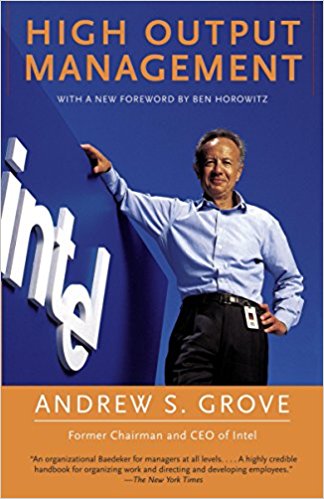High Output Management Summary

<1 min read ⌚
 High Output Management is the essential book of late Andy Grove, the former CEO of Intel, focused on managers, directors, and CEOs. If you have a team, a company or if you relate to many people in your day to day and have to balance the interests of your team, this book is mandatory for you.
High Output Management is the essential book of late Andy Grove, the former CEO of Intel, focused on managers, directors, and CEOs. If you have a team, a company or if you relate to many people in your day to day and have to balance the interests of your team, this book is mandatory for you.
The focus of High Output Management is to make it clear that the key feature of a good manager is focused on results, output, and thus teach you how you can deliver more results by understanding how a corporation should work.
In a company, your personal result is equivalent to the result of all teams and departments under your supervision or influence.
Your team will only achieve real high performance if each member has an understanding of their required output and clarity of what their role in the company is.
“High Output Management Summary”
UNDERSTANDING THE PRODUCTION LINES:
Efficient production lines operate on three assumptions: Deliver your products on time, with a clear quality standard and within the defined cost. To ensure that these assumptions are met, you must ensure that your production line follows these steps:
- Manufacturing: the stage in which the elements of your product are grouped;
- Assembly: when the components are grouped together forming a new item;
- Tests: the examination of the characteristics of the product. To optimize your production line, you need to be aware of “bottlenecks” (time-consuming, more resources, where more failures occur, etc.) steps to optimize it. Once the most complex step is optimized, move to the second, third, and so on. To monitoring to be ensured, there are the KPI’s or Key Performance Indicators indicators.
Even a basic indicator is better than having no indicator at all. Good indicators measure the result, the output of a process and the number of activities carried out. Choose an indicator for each goal sought and analyze them individually and comparatively, because almost always one indicator impacts directly on others.
An example: the number of units produced per day (speed indicator), if increased dramatically, can compromise the number of defective products per day (quality indicator). In addition to follow-up indicators, there are also indicators that can predict outcomes and trends by measuring the results of a process over a period of time.
An example of the use of this scenario would be to track one indicator as output per employee per month.
Through it, you get to know, over time, whether you’re getting more or less efficient and even design how many employees you’d need to hire to achieve your goal of increasing the parts production.
DISCOVER YOUR MANAGEMENT LEVERAGE
Leverage is the measure of the result generated by each manager. Andy uses the following formula to describe it:
Manager Output = output of his direct reports + output of the other teams that benefit from his knowledge.
To ensure maximum performance, you need to be aware of your managerial role, which includes collecting information, multiplying information for the team, making decisions, being an example to the team, and compiling reports frequently.
Management reports are essential for communication but are even more important to the manager’s self-discipline.
Producing them is usually more important than consuming them. To delegate efficiently, it is necessary for a manager to have constantly analyzed information, strategic knowledge about the business, and also communication and leadership skills.
High Output Management
According to Andy, a manager must have between 6-8 subordinates. Less than 6 can cause a slowdown in the company, and more than 8 can lead to confusion in the communication.

HOW TO HAVE EFFICIENT MEETINGS
Meetings have great leverage when used effectively, but care must also be taken that they do not become a waste of resources. They must be of the following types:
- 1:1’s – Meetings between manager and subordinate to exchange knowledge and feedbacks. The manager should listen, ask questions and try to use the opportunity to find problems and be an effective coach for the team member. The purpose of this meeting is to increase the mentee’s understanding of her role and to help her produce more and grow. Its frequency depends on the experience of the subordinate in the job, but it is generally recommended that it occur once a week for non-experienced staff, lasting less than an hour. This meeting is highlighted by Andy as one of the most important in all types of companies.
- Team Meetings – These should be used to discuss topics that affect more than two people. The role of the manager is to facilitate the meeting, to control its pace and to follow up so that the matter is resolved there. Its role is to help the team make decisions. Mediation of conflicting views is a great exercise for the manager to have more understanding of the issues at stake.
- Operational Reviews – Starts with a presentation and discusses the results of the process. It is also a way to help people who do not necessarily interact on a daily basis to get to know each other and exchange ideas. Having focused and using these practices, it is possible to successfully follow the company’s results and align everyone involved.
HOW TO MAKE BETTER DECISIONS
To make wise decisions, it is important always to involve experts on the subject.
Not always, as a manager or CEO of a company, you must make all the decisions. In general, decisions must go through 3 stages: Free discussion with stakeholders, clear decision with a plan of action and communication of the total support of the management to the decision maker.
Full support does not necessarily mean agreeing with everything but instead communicating that you agree with the plan to be followed.
In general, it is best that decisions are made by the middle-tier managers of the company, after all, they combine a mixture of specialized knowledge and authority.
The most significant obstacle to good decisions is that people do not always position themselves transparently on the subject.
A meeting with only people of the same managerial level does not bring good decisions, as they tend to seek consensus. If there is no manager involved, it is important that the most senior professional approves the final decision in the group.
Another critical factor is always to consult others before deciding because if you make decisions without consulting, the other members of your team will also make decisions without consulting their teams.
PLANNING WITH A FOCUS ON RESULTS
Planning is critical to results-focused management, and it is important that you do it as a manager, not by an isolated professional.
The manager is aware of his resources and understands that planning is to say yes to some projects and no to others. Planning is based on 3 basic steps.
- Understand the demand – What the environment, the company or your team will need you and for how long.
- Understand the current situation – What you are producing now when these projects will be completed and what the impact of adding new projects in the short term.
- Compare the demand with the current situation and derive a plan – What needs to be done to ensure that demand is delivered? How much time and resources are needed? Planning (the strategy) should produce tasks (the tactics) that need to be done now to change future events and meet the needs of the demand raised. The planning process output, therefore, is the set of decisions made based on the planning process. It is important to remember that after planning, it is important to separate some time to consider the impact of that planning and those decisions. Saying yes to one project means saying no to others.
UNDERSTAND OBJECTIVE MANAGEMENT CONCEPT (OKR’S)
Management by objectives or OKR’s (Objectives and Key Results) should be used to ensure speed after planning.
Set your goals by asking “Where do we want to go?” From there, list the key results you expect to know if you are getting there.
Choose critical areas and focus. Also keep the results always specific, so that it is clear what we can do and where we fail.
TRAINING YOUR TROOPS
You, as a manager, can improve the performance of your employees and subordinates by developing motivation (developing self-esteem and acknowledging the contributions of individuals) and training.
Self-esteem and the development of the individual are the two keys to this process. While self-esteem and motivation are finite resources, not being able to count on them always, the technical and personal development, as well as the ability to acquire new knowledge from people, are infinite.
People, in general, develop in different ways:
- Competency development: The member is continuously focused on mastering his task, seeking to become a virtuoso, a great specialist and thus obtain recognition;
- Achievement development: The person is focused on “winning” and “achieving goals” in everything he does. Both approaches lead people to overcome and test their limits, whether at the level of skill or at the level of achievement. Behaviors focused on skill development should not be rewarded with recognition; after all, they are not necessarily aligned with the company’s goals. Development focused on achievements and realizations must be fostered in every organization. An accomplishment is always a result, an output.
MATURITY CONCERNING THE TASK: THE SECRET TO DELEGATE
Maturity concerning the task (a term initially coined by Grove as task-relevant maturity) is a criterion used to define how each type of subordinate is managed.
It takes into account the level of maturity it presents in order to adopt a different style of management, either through directive management (directions and explanations), objective (focused on goals and results, but offering mentoring) or delegation focused on leadership (involvement of the manager in the execution of the task close to zero, only in monitoring the results and motivation of the individual).
- Low maturity: The individual with low maturity in relation to tasks has little experience in the required area. He may be a new or new employee in that profession and needs to be managed accordingly.
It is necessary to explain the task in detail, as well as the expected results, the resources needed and the step-by-step to execute it. The style should be directive, asking the employee to take notes and ask questions. Your first goal with this individual, as a manager, is to make sure that he can complete the task and become effective, competent and trustworthy. - Average maturity: At the intermediate level, the professional already has some experience with the specific task. They already have a certain level of competence in the area and are more confident in their ability to execute.
Still, this experience may be limited and, in this case, its management must follow an objective style. Explain clearly the objectives and expected results of the task and ask this person how they would do the task to meet your expectations. Let them develop the execution plan. T
rack progress gradually, but leave the burden of discovering the necessary resources and step by step to reach the goal.
Ask them to find out for themselves and only come to you if they are absolutely stuck. Otherwise, you may be “reverse delegating”, meaning giving them a job that will just give you more work.
Your goal here is to develop in the professional the ability to come up with real solutions without depending on you. Your role is as coach and mentor of this employee. - High maturity: With high maturity, the individual has great experience in the requested field and can be considered an expert, having, even more, knowledge than you in the area of activity. In this case, the recommended management model is the delegation of leadership.
Focus on having a very high alignment with the expected result or let the professional decide for himself the expected result. Make it clear that they will be evaluated for their results only and give them full autonomy to pursue them.
Let them run alone and trust.
This confidence, of course, comes from the professional’s experience in executing similar projects previously. To develop on team management and your delegating ability, it is important that the responsibilities of each role in your company be very well defined, regardless of the maturity of each person.
It is also necessary to make it clear to people that each of them will be evaluated differently at each maturity level.
As you develop as a manager, increasingly seek to master your skills to leverage yourself through the delegation of responsibilities. Master the concept of maturity about the task and watch your productivity grow as you help the professionals around you to grow and develop. Your team will thank you.

MASTERING PERFORMANCE EVALUATIONS
A talented manager understands the importance of measuring the performance of his team since the performance of all the members of the team added is his performance.
Performance analysis is a fundamental tool to provide relevant feedback to the task performed by a subordinate. Your goal is to improve the performance of the individual according to their skill level and also maintain their motivation.
For good evaluations, always: clarify in advance the result you are seeking for the professional; Outcome measures (e.g., number of products delivered, number of defects, etc.); Evaluations of internal actions taken (i.e., planning, training, contracting, etc.). During the assessment, stay out, listen attentively, focusing on the individual. Your goal is to be committed to finding solutions. A common pitfall in which many managers fall is to evaluate people based on their potential rather than their results.
TWO DIFFICULT TASKS, YOU WILL HAVE TO GET USED…
If you are a manager, there are two extremely difficult tasks that are part of your day-to-day life: hiring qualified professionals and dealing with the exit of talented ones. The key to hiring is to develop the ability to interview candidates.
When interviewing candidates, you should always focus on measuring your knowledge, your past performance, and identifying potential cultural discrepancies with company values. Let the candidate talk most of the time and just interrupt and change the subject if the conversation loses focus.
Draw scenarios, allow candidates to ask questions but stay focused on the topics above. Saving time in interviews is also important.
The other complicated situation is when an essential professional, the guy you absolutely do not want to lose, asks for resignation. When dealing with talented people who resign, give immediate attention to the matter as soon as you know the news.
Always seek alternative solutions, offer departmental transfers, consult supervisors and do your best to retain your key talent.
TRAINED TEAMS, MOTIVATED TEAMS
For Andy Grove, you as a manager have two main responsibilities: team motivation and training. Training must be incorporated into the culture and business processes in depth. It is extremely important that the training has a clear, documented, consistent and repeatable process within the organization.
Training should not be something with a scheduled date, which occurs every month in the first week.
The training must be continuous and part of the daily operation of the companies, so that the professional can perform his tasks. Motivation is the complementary tool that helps the professional to improve his performance and acquire his mastery.
LET’S TALK ABOUT MONEY? PAYING YOUR TEAM
Managing team compensation is a very common challenge for managers and is where many mistakes happen. There are two classic forms of wage management, one based on the experience of the employee and another based on their merits.
Companies generally use a combination of both, but it is necessary that job promotions within the company are always tied to performance, results, aiming to highlight company values. Do not make the mistake of paying for potential or experience!
Like this summary? We’d Like to invite you to download our free 12 min app, for more amazing summaries and audiobooks.
“High Output Management” Quotes
We must recognize that no amount of formal planning can anticipate changes such as globalization and the information revolution we’ve referred to above. Does that mean that you shouldn’t plan? Not at all. You need to plan the way a fire… Share on X Let chaos reign, then rein in chaos. Share on X The key to survival is to learn to add more value. Share on X The absolute truth is that if you don’t know what you want, you won’t get it. Share on X Adapt or die. Share on XFINAL NOTES
High Output Management is required reading for every manager, director or CEO. The book is such a comprehensive guide that it becomes difficult to summarize all the key points. The most fundamental concept, however, is that the manager’s focus is to monitor the quality and quantity of each department’s deliverables.
A very common mistake for managers is to spend too much time on meetings, connections, and forget about focusing on the outcome.
The great manager knows exactly what the expected measurable result of his or her job is and always seeks to improve it, either by training his subordinates and educating them about the importance of their role and their metrics in the company as a whole or by promoting them based exclusively on results and never “potential”.








